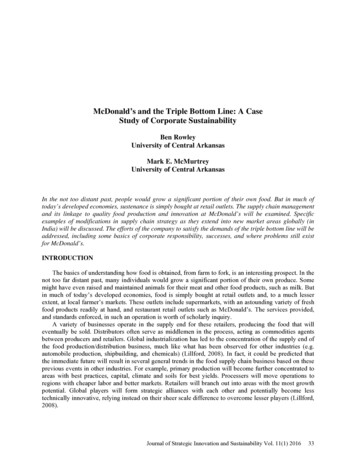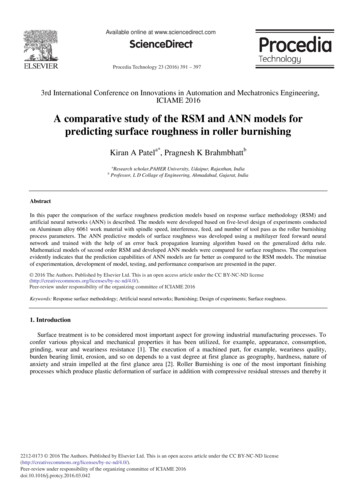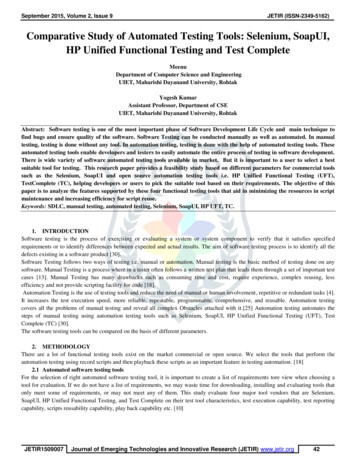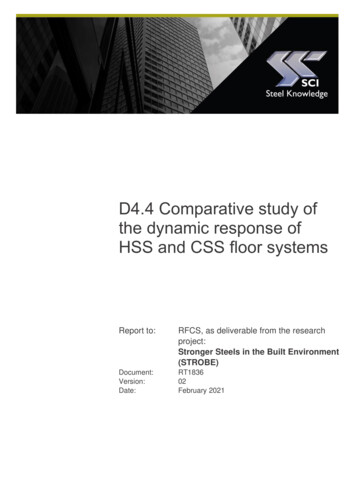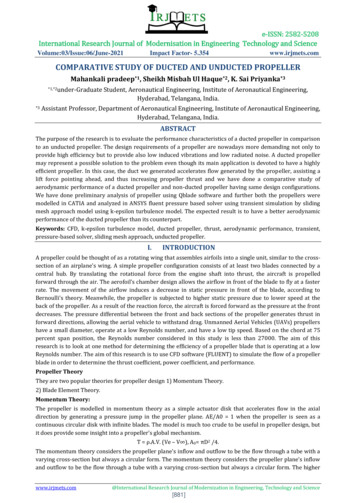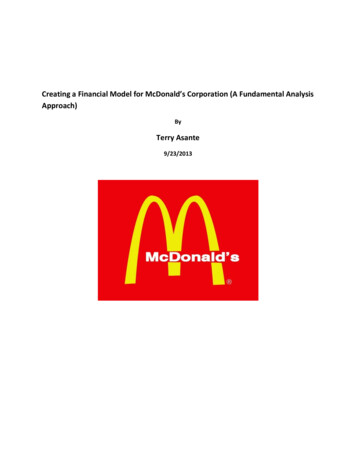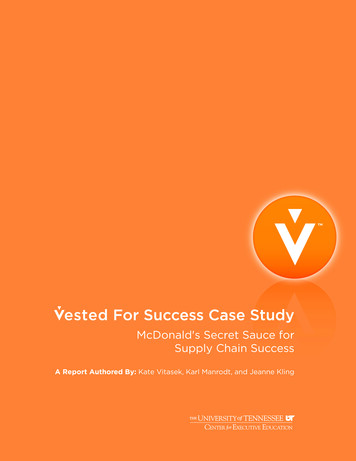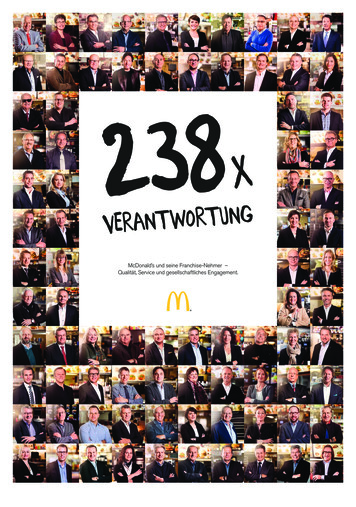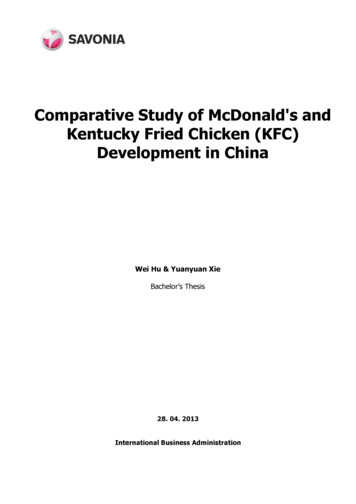
Transcription
Comparative Study of McDonald's andKentucky Fried Chicken (KFC)Development in ChinaWei Hu & Yuanyuan XieBachelor’s Thesis28. 04. 2013International Business Administration
Bachelor’s degree (UAS)SAVONIA UNIVERSITY OF APPLIED SCIENCESTHESISAbstractField of StudySocial Sciences, Business and AdministrationDegree ProgrammeDegree Programme in International BusinessAuthor(s)Wei Hu & Yuanyuan XieTitle of ThesisComparative Study of McDonald's and Kentucky Fried Chicken (KFC) development in ChinaDate28.04.2013Pages/Appendices53 2Supervisor(s)Jari Niemelä &Heikki LikitaloClient Organization/PartnersMcDonald's Corporation & Kentucky Fried Chicken CorporationAbstractMcDonald's and KFC are two international fast food restaurants. They both expended theirbusinesses in global scale. It is obvious that McDonald surpassed KFC in terms of sales and famein international level. However, in China, KFC performs better than McDonald's.The aim of this study is to find out how these two companies developed differently in Chinesemarket. By making a comparative study of McDonald's and KFC, different operation andcompetitive strategy theory will be integrated with their development situation. Research is madebased on strategy theory, Internet sources and interviews.The thesis is started with general information, Chinese fast food industrial situation introductionand thesis structure. After having introduced the two companies background, we illustratedstrategy theory as thesis theoretical basis. Next, by comparing McDonald’s and KFC’s corecompetitive power, we analyzed the main difference and some similarities comprehensively ofMcDonald’s and KFC’s business and competition strategy.In research finding chapter, we introduced qualitative finding, it is the main research method wehave used. The thesis is ended in conclusion, after main finding, recommendation will be given toother international fast food restaurants and suggestions will be given for further research.KeywordsComparative study, business strategy, competitive strategy, fast food development
3CONTENTS1INTRODUCTION . 51.1The background of Chinese fast-food development . 51.2Research Introduction . 71.3Thesis structure . 82CASE COMPANY INTRODUCTION . 102.1The background of McDonald’s . 102.2The background of KFC . 113RESEARCH PROCESS AND METRHODS . 133.1Research objective. 133.2Research methodology . 133.3Qualitative findings . 143.4Thesis analysis methods . 153.4.1Case study method . 153.4.2Comparative study method . 153.5Interview findings. 153.5.1Interview with managers . 153.5.2Interview with customers . 164AN OVERVIEW ABOUT BUSINESS STRATEGY . 184.1What is the business strategy . 184.2Aims and procedures of business strategy . 194.3Competitive strategy. 205COMPARISON OF MACDONALD’S AND KFC BUSINESS STRATEGY . 235.1Comparison of McDonald’s and KFC core competitiveness . 235.2Comparison of McDonald’s and KFC operation strategy---Growth strategy . 255.2.1Comparison of McDonald’s and KFC chain-store operations model . 255.2.2Comparison of McDonald’s and KFC operations area . 295.3Comparison of McDonald’s and KFC competitive strategy . 315.3.1Comparison of McDonald’s and KFC cost leadership strategy . 315.3.2Comparison of McDonald’s and KFC’s differentiation strategy . 336CONCLUSION . 446.1Main findings . 446.2Recommendation for international fast-food companies . 466.3Suggestions for further research . 47REFERENCES . 48
4APPENDEX 1 Interview with customers . 54APPENDEX 2 Interview with managers . 55
51INTRODUCTIONAs two of the world's largest fast-food giants, McDonald's and Kentucky Fried chicken(KFC) are both from the United States. Hu Wei and Xie Yuanyuan were surprised tofind that there was no KFC in Finland, although KFC can be seen everywhere inChina. In addition, they have a different way of development. Due to this situation, wewant to find out how these two companies developed differently in Chinese market.Hu Wei and Xie Yuanyuan wrote this thesis. Hu Wei was mainly responsible forquestion introduction, methodology and KFC parts. Xie Yuanyuan was mainlyresponsible for theoretical basis, thesis analysis methods and McDonald’s parts.1.1The background of Chinese fast-food developmentThe fast food industry in China started late in April 1987, the KFC fast-food chainstore entered Beijing, and opened a prelude to the fast development of modernChinese fast food. The Chinese fast food industry in the context of GNP in the 1990sof the last century having an year-on-year growth of 10% had a rapid growth to up toa 20% annual growth rate with an industry profit margin always up to 10%-20%, so asto gradually become an important force in support of sustainable development in thefood and beverage industry and a new economic growth point. In the end of 1996,China had about 800 professional fast-food companies, nearly 400 thousand fastfood stores and the annual turnover of the fast-food industry reached 40 billion Yuan,accounting for about 1/5 of the total food and beverage industry. In 1999, the nationalfast-food enterprises stores constituted over 800 thousand, the fast-food industryturnover reached 75 billion Yuan, accounting for 1/3 of the total food, and thebeverage industry and its turnover over the previous year had an increase of 20%,which was 7% higher than the average increase of the food and beverage industry.(Xiao 2005)At 1999, the development and social needs of the fast food industry in China werenot quite compatible, mainly represented in the slow development of Chinese fastfood varieties, backward production technology, low industrialization and organization;the development of Chinese fast food business was still in the stage of learning,imitating and experience accumulating It had not yet formed its system and scale.(Xiao 2005)
6Since the beginning of the 21st century, China's fast food industry has made asustained and rapid development. According to the research, the annual turnover ofthe fast food industry in China has been more than 200 billion Yuan after 2000, chainstores have exceeded 1 million, and the rapid development has reached a growthrate of 20% per annum. In 2004, China's fast food industry had formed its basicsystem and scale and its basic shape of the consumer market and supply market withboundless vigour and vitality, among which, with the strong momentum of thedevelopment of Western-style fast food, McDonald's and Kentucky Fried Chicken fastfood had led the Chinese market. In contrast, the Chinese fast food business had tofurther improve their competitiveness. According to a Ministry of Commerce researchthe fast-food market share in Guangdong province was as high as 90%, while theshare thereof in the relatively developed coastal provinces such as Jiangsu,Shanghai, Liaoning, Beijing, Zhejiang and Shandong was more than 50%. (Xiao,2005)In addition, Chinese fast food industry had also made a rapid development as a resultof strong market demand and attractive business profits. In early November 2006, thefast-food restaurant from Guangdong province, Real Kung Fu (Beijing New World)Global Chinese Dining Chain Store, officially opened a store in the capital city, whichwas the sixth store in Beijing of this fast food chain enterprise that previously focusedon the southern market. Mr. Cai Dabiao, president of the Real Kung Fu, announcedthat ”Real Kung Fu would open 35 stores in Beijing in 2008 and have up to 1,000stores across the country in 2010.” The development of Chinese fast food enterprisesis rapid as these example show. The country's macroeconomic policy also promotesthe rapid development of Chinese fast food. Premier Wen Jiabao signed in February2007 the State Council Order No. 485, which announced that the Administration ofCommercial Franchise Ordinance should come into force on May 1, 2007, when theconcession retail enterprises, especially fast food enterprises, would face a majorreshuffle. Franchisee operations would become the mainstream model of the fastfood industry and its development prospects would be better. (Xiao 2005)With the booming Chinese economy, when the fast-food market demand is furtherincreased, together with the aggressive competition from McDonald's and KFC,Chinese fast food industry faced both more opportunities and challenges. How couldChinese fast food grasp market trends and continue to grow in the future? Through acomparative study of the business strategy and competitive strategy of bothMcDonald's and KFC, there comes a lot of experience that could be learned andapplied by Chinese fast food. Chinese fast food business also can make use of its
7comparative advantages and continue to convert them to competitive ones, so as tomake effective defence against McDonald's and KFC’s competitor in the futuredevelopment and change their leading roles in China's fast food industry. (Xiao 2005)1.2Research IntroductionWith the developing of living standards, fast food is increasingly being accepted inpeople’s lives. It has become an integral part of the daily food. In recent years, therise and development of the fast food industries have become a very interestingphenomena in the Chinese market. McDonald's and KFC have sales mode with agood quality, excellent services and a clean environment to attract customers.McDonald's is ranked at the top of the fast food industries with over 33,000 outlets,whereas KFC only has 11,000 outlets in 80 countries, ranking at 7th in the world. Theinformation of McDonald's and KFC will follow the Table 1. (Wikipedia 2012)TABLE 1: McDonald’s and Kentucky Fried Chicken information (Wikipedia 2012)Company name:McDonald’sKentucky Fried Chicken (FKC)Type:PublicSubsidiaryHeadquarters:Oak Brook, Illinois, U.S.Louisville, Kentucky, U.S.Number of locations:33,000 worldwide, 700 China11,000 worldwide, 1500 ChinaProducts:Fast food (hamburgers, chicken,Fried chicken, grilled chicken,related Southern foods andAsian foods.French fries, soft drinks, lAccording to our research, KFC's sales, store number, reputation exceed that ofMcDonald's in the Chinese market. Both of us want to understand how these twocompanies developed differently in Chinese market. . Due to differences in strategy,we think that we should proceed from the angle of development strategy to study. Atpresent, Chinese and foreign fast-food entrepreneurs are all concerned aboutMcDonald's and KFC’s development in the Chinese market and they secretly beganto follow them in a Chinese fast-food market. We use the method of comparativestudy on the development strategy of McDonald's and KFC to get more usefulstrategies that can help Chinese and foreign enterprises in this area. (Xiao 2005)
8In addition, our choice to use this subject is based on both multinational fast foodcompanies and Chinese fast food. We can study how KFC uses the resourceadvantages and disadvantages to expand business in China, and how to implementthe strategy of localization in this big market. Compared with McDonald’s in China,KFC has gained the competitive advantage obviously so far. So it lets us have thecuriosity and interest towards them. At the same time, China is a growing a superfast-food market in the 21st century. (Xiao 2005)On the one hand, due to the slow growth of the national economy in recent years, theUnited States domestic market has been saturated by fast-food industries. On theother hand, since China’s WTO entry, the Chinese household electrical appliancesindustry, as well as other industries, is facing the reality of a globalizing worldeconomy and multi-global challenges, such as the environmental challenge, thecompetitive challenge, the collaborative challenge, the organizational challenge, theworldwide learning challenge and the management challenge. To McDonald's andKFC, China has an abundant market with threats and opportunities. They need tochoose
comparative study of the business strategy and competitive strategy of both McDonald's and KFC, there comes a lot of experience that could be learned and applied by Chinese fast food. Chinese fast food business also can make use of its . 7 comparative advantages and continue to convert them to competitive ones, so as to make effective defence against McDonald's and KFC’s competitor in the .

